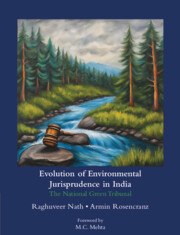Book contents
- Frontmatter
- Dedication
- Contents
- List of Images
- Foreword
- Preface
- Acknowledgements
- List of Abbreviations
- 1 Introduction to the National Green Tribunal: The Need for a “Green Court”
- 2 The National Green Tribunal Act, 2010: Analysis and Interpretation
- 3 Interpretation and Application of Environmental Principles
- 4 Evaluating the National Green Tribunal after a Decade: Challenges to Overcome
- Interview with Justice Swatanter Kumar
- Interview with Vimal Bhai
- Index of Cases
Preface
Published online by Cambridge University Press: 15 January 2025
- Frontmatter
- Dedication
- Contents
- List of Images
- Foreword
- Preface
- Acknowledgements
- List of Abbreviations
- 1 Introduction to the National Green Tribunal: The Need for a “Green Court”
- 2 The National Green Tribunal Act, 2010: Analysis and Interpretation
- 3 Interpretation and Application of Environmental Principles
- 4 Evaluating the National Green Tribunal after a Decade: Challenges to Overcome
- Interview with Justice Swatanter Kumar
- Interview with Vimal Bhai
- Index of Cases
Summary
The ‘India Story’ – in all the multitude of senses and contradictions that it is perceived – is largely a story of collective amnesia coupled with the thirst to regain a lost glory. To put this into perspective, India's share of global gross domestic product (GDP) went from around 24.2 per cent in the early 1700s to about 2.3 per cent around the time of its independence – a reduction of over 90 per cent after more than two centuries of colonialism. At the same time, India's population more than doubled. Thus, in addition to the extreme economic depredation, poverty, and burden there was a deep-seated sense of injustice and the need to regain the lost economic and political glory India enjoyed a few centuries ago.
This India Story has fashioned, and continues to fashion, most political and socio-economic narratives, discourses, and policies in India.
However, this India Story is intricately linked to, and dependent on, the story of India's natural environment. The development of Indian environmental jurisprudence, since India's independence, has been an effort to make sense of this dependence. This effort by no means has been easy. It has been fraught with challenges of a different order. Significant competing interests of uplifting millions out of extreme poverty, while heavily relying on an already plundered environmental inheritance, has made the legal and regulatory landscape tremendously challenging.
Accordingly, the evolution of Indian environmental jurisprudence, essentially, is an evolution of the legal response of the Indian judiciary while navigating these complex and competing rights and interests, within the larger context of the India Story. The Indian judiciary, led by the Supreme Court of India, has time and again espoused novel environmental principles and has modified the application of legal precedents in response to various competing considerations. This has included the creation of dedicated environmental law courts in the country.
The aim of this work is to explore the impact of legal trends and inconsistencies, and highlight different dominant considerations at play within the evolution of Indian environmental jurisprudence. In doing so, it seeks to contextualize and situate the recent adjudicatory trends, particularly of the National Green Tribunal (NGT), within the larger adjudicatory framework carved out over the decades by the Supreme Court of India.
- Type
- Chapter
- Information
- Evolution of Environmental Jurisprudence in IndiaThe National Green Tribunal, pp. xiii - xivPublisher: Cambridge University PressPrint publication year: 2025

